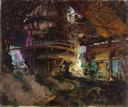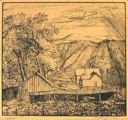Richard B. Coe
American
(Selma, Alabama, 1904 – 1978, Goldens Bridge, New York)
The subjects and style associated with Regionalist art struck a resounding chord with Southerners in the 1930s and 1940s. Traditionally, the economy of the American South was overwhelmingly agricultural, producing an insular society that revolved around local issues and community. Nascent industrialization after World War I was hindered and overshadowed by poverty and despair during the Great Depression. Regionalism was a national (and nationalist) movement, but its Southeastern articulation had a profoundly local aspect, grounded in the political philosophy of The Agrarians, a group of writers loosely associated with Nashville and Vanderbilt University. Twelve of these writers emphasized the importance of traditional regional values and warned against the dehumanizing effects of industrialism in an influential and popular book-length treatise titled "I'll Take My Stand: The South and the Agrarian Tradition" (1930).
The fear of change and societal instability encouraged a general conservatism that extended to the art created by painters such as Kelly Fitzpatrick and Richard Coe, a native of Selma, Alabama. In 1932 a Birmingham newspaper awarded Coe an art scholarship that allowed him to study in New York and later in Boston. He then spent two years traveling in Europe before returning to Alabama in 1934 and establishing a studio in Birmingham. For a time, Coe served as the head of the Alabama section of the Works Progress Administration, a federal support program for artists. He later studied and taught in both Colorado and Maryland before settling in upstate New York.
In the New York art world of the 1930s, there existed an acceptance, and indeed a reliance, on the varied expressive means that had been introduced by European Modernists in the early years of the century. Outside of the metropolis, however, the mood was decidedly less secure and inclusive. Coe’s attitudes, as expressed in a 1934 newspaper article, seem to reflect the general tenor of these times in the South and elsewhere in America’s heartland:
The art spirit (art for art’s sake) created in the nineteenth century is all well and good, but there is an art for the people. The government is doing its best to develop it by taking charge and giving work to artists to do art for the education and delight of the people. American art for American people is a slogan well worth heeding. The art world patronized by a select group, which gets into trends and popular fancies, is not worth considering…. Painting should be a pleasant thing to do and to view. Look at a picture, for instance, and say: “Would you like to be there?” That’s one way of telling that you like it, and if you like it then it’s good…. The modernistic era has passed. A “new deal” in art has come in with all the other “new deals.” The government has it in its power to create a good one…. We are an educated race and use painting as a useful purpose. (1)
(1) Dolly Dalrymple, “Winner of Scholarship Returns on Visit,” Birmingham News, 9 May 1934.
American Paintings from the Montgomery Museum of Fine Arts, 2006, cat. no. 80, p. 192.
Image credit: Richard B. Coe, photograph of clipping from "The Reporter Dispatch," White Plains, NY, Wednesday, September 16, 1970, Courtesy of the Dixie Art Colony Foundation, Wetumpka, Alabama, DixieArtColony.org
American
(Selma, Alabama, 1904 – 1978, Goldens Bridge, New York)
The subjects and style associated with Regionalist art struck a resounding chord with Southerners in the 1930s and 1940s. Traditionally, the economy of the American South was overwhelmingly agricultural, producing an insular society that revolved around local issues and community. Nascent industrialization after World War I was hindered and overshadowed by poverty and despair during the Great Depression. Regionalism was a national (and nationalist) movement, but its Southeastern articulation had a profoundly local aspect, grounded in the political philosophy of The Agrarians, a group of writers loosely associated with Nashville and Vanderbilt University. Twelve of these writers emphasized the importance of traditional regional values and warned against the dehumanizing effects of industrialism in an influential and popular book-length treatise titled "I'll Take My Stand: The South and the Agrarian Tradition" (1930).
The fear of change and societal instability encouraged a general conservatism that extended to the art created by painters such as Kelly Fitzpatrick and Richard Coe, a native of Selma, Alabama. In 1932 a Birmingham newspaper awarded Coe an art scholarship that allowed him to study in New York and later in Boston. He then spent two years traveling in Europe before returning to Alabama in 1934 and establishing a studio in Birmingham. For a time, Coe served as the head of the Alabama section of the Works Progress Administration, a federal support program for artists. He later studied and taught in both Colorado and Maryland before settling in upstate New York.
In the New York art world of the 1930s, there existed an acceptance, and indeed a reliance, on the varied expressive means that had been introduced by European Modernists in the early years of the century. Outside of the metropolis, however, the mood was decidedly less secure and inclusive. Coe’s attitudes, as expressed in a 1934 newspaper article, seem to reflect the general tenor of these times in the South and elsewhere in America’s heartland:
The art spirit (art for art’s sake) created in the nineteenth century is all well and good, but there is an art for the people. The government is doing its best to develop it by taking charge and giving work to artists to do art for the education and delight of the people. American art for American people is a slogan well worth heeding. The art world patronized by a select group, which gets into trends and popular fancies, is not worth considering…. Painting should be a pleasant thing to do and to view. Look at a picture, for instance, and say: “Would you like to be there?” That’s one way of telling that you like it, and if you like it then it’s good…. The modernistic era has passed. A “new deal” in art has come in with all the other “new deals.” The government has it in its power to create a good one…. We are an educated race and use painting as a useful purpose. (1)
(1) Dolly Dalrymple, “Winner of Scholarship Returns on Visit,” Birmingham News, 9 May 1934.
American Paintings from the Montgomery Museum of Fine Arts, 2006, cat. no. 80, p. 192.
Image credit: Richard B. Coe, photograph of clipping from "The Reporter Dispatch," White Plains, NY, Wednesday, September 16, 1970, Courtesy of the Dixie Art Colony Foundation, Wetumpka, Alabama, DixieArtColony.org
Artist Objects



